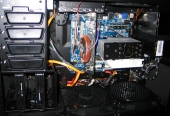Installation
Before we begin, a quick note about tools. Many people run into all kinds of difficulties getting their hardware into a case in one piece, and this can be avoided with the presence of a few simple tools:
- #1 Phillips head screwdriver, with a shaft at least 4″ long
- Needle-nose pliers with wire cutter
- Tweezers
- Anti-static wrist band
- Large syringe of thermal paste
- Paper towels
- Shallow bowl or empty egg-carton for loose screws
You can get much fancier with tool kits, of course, but this short list contains everything you need to get your system installed with a minimum of fuss.
Getting my system installed into this case had a few tricky moments to it, but thankfully all the odd bits were covered in the manual. Major kudos to whoever wrote that manual, it does a very good job of laying out the steps needed to go from empty chassis to installed system in a clear manner. Unlike many others of its ilk, this manual interweaves the translated text into each step. This helps to avoid the usual malaise: a pathetic little pamphlet bound together with five or six copies of itself in different languages, with cramped illustrations and text printed in Flyspeck Sans 4pt. If Lian Li and Antec take no inspiration from the chassis itself, they at least need to take a long look at the manual.
Getting the motherboard mounted was fairly uneventful. Once the proper standoffs had been screwed into the tray, I had only to pop the I/O backplate into the slot, ease the motherboard onto its standoffs, and go to work with a screwdriver. Note that the space between the edge of the motherboard and the PSU may be tight if your CPU cooler is large, so you’ll want to leave off installing the PSU until the last.
Getting the hard drives and optical drive installed was similarly uneventful. I chose to use the top slot for my DVD writer, which meant I had to use a quartet of case screws to secure it instead of the push-lock system. Here is where the long-shaft screwdriver came into play; the clearance between the mounting screw holes and the top case lip was rather narrow, and would have caused problems for a short screwdriver. Getting the hard drives in place was trivial, thanks to the caddies. Also of note was the low clearance behind the top slot; unavoidable due to the position of the expansion slots. Putting the drive there necessitated the use of right-angle plugs for power and data. If you don’t have such plugs, or have a longer drive, you’ll need to use one of the lower four bays.
Mounting the PSU was a bit trickier than usual, owing to its odd positioning. The best method seemed to be to feed both ends of the Velcro strap through the slots on the motherboard tray, and leave them hanging while I held the PSU up to the top bracket and screwed in the case screws. With that accomplished, I winched the Velcro strap down tight, and held the corner cap in place while attaching it to the motherboard tray with another pair of screws. These are not strictly necessary to hold the PSU in place during use, but they do add a bit of security during transport.
The last major step was, of course, running all the wires and cables to their needed spots. The generously-sized tray cutouts helped to keep the cables mostly out of the way, although some creative arrangement was needed to keep them from bunching up at the bottom. Here I should note that the intake fans are wired in a non-standard way: the live wire runs up to the switch box at the top before coming back down to the fan body. This allows the fans to be toggled between high and low speeds when connected to the Molex header. If you plan on using these fans with a fan controller bus or system-controlled motherboard headers, you’ll need to set the switches to “H” to get accurate speeds and voltages. The top exhaust fan uses a standard 3-wire header, with no fancy switches.
 |
| Here’s the result of a half-hour’s work at installation, including a few re-reads of the manual. |
Conclusion
There’s a lot about this case to love. The styling is impeccable, and the combination of the rotated motherboard mount and pop-off top cover mean that it’s possible to have all your wires tied up in one neat bundle as it exits the back of the case wire-guide. The position of intake and exhaust fans ensures a straight-line airflow from bottom to top, which works with natural convection to get the heat out of your case in a hurry. The fans themselves are whisper quiet in normal use, and don’t make much more than a low hum when cranked to full. The combination of a solid, single-piece frame and copious use of acoustic foam make for a case that doesn’t vibrate, shake, rattle or flex. If this case fell off of your desk, you might worry about the parts inside, but you definitely would not worry about the case.
There are a few trouble spots that deserve mention, however. The tightly-packed hard drive caddies don’t allow for much airflow over the hard drives when all five are in use, which could be detrimental to the health of your drives. Reducing the number of drive slots by one in favor of spacing them out more would do a lot to improve airflow overall. There’s also no ducting to shunt the hot air away from the drives once it reaches the top, which could create a pocket of hot air in a tightly-packed system. The wiring harness for the intake fans, while cleverly done, is messy and unfortunately eye-catching.
Finally, there are a few considerations that have to be taken into account with regards to the rotated motherboard mount. First is a simple matter of size: this motherboard will not support an Extended ATX board, due to their increased width. Boards that are a bit wider than the norm, such as the ASUS Maximus III Formula, will fit, but it will be a tight fit. This also holds true for video cards: if your card is especially long, you’ll want to pay close attention to the clearance. While the vast majority of GPU coolers will function just fine with this vertical arrangement, any passive coolers that rely on heatpipes attached to the card’s backside will not work properly in this orientation. A blower-style cooler that exhausts heat out of an unused expansion slot will function best with this setup. Care must also be taken with the exhaust pattern of your CPU cooler: a tower-style cooler that blows its exhaust towards the “rear” of the board works best, as it lines up in a straight-line push-pull configuration with the rearmost intake and exhaust fans. Because of the large mismatch between the power of the intake and exhaust fans, this case has what is known as a positive-pressure environment when in use. This helps with pushing hot air out of the system, but can create major issues with dust if the intake filters are not regularly cleaned. You’ll definitely want to pop the door and clean them out every couple of months to keep things flowing smoothly.
The only remaining question is, is this case worth buying? At $240 MSRP, it’s certainly not for the faint of wallet, but what you get is a top-notch chassis. Possible clearance issues aside, the gripes mentioned are only small blemishes on an otherwise exemplary system. I can’t think of a better chassis in the mid-tower category, which is why I’m awarding it an Editor’s Choice award.


Absolutely awesome case. It gets better the more you look into it. Plus Silverstone does a really excellent job on the fit and finish of their products. A+ for the engineering team over there.